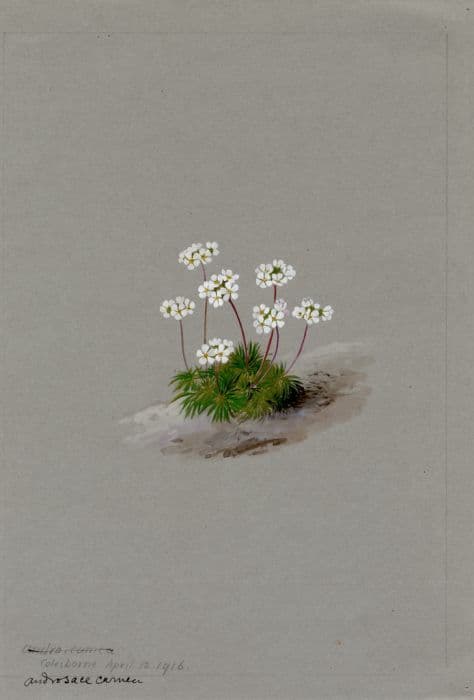Bear's ear auricula Primula auricula 'Rolts' (Au/s)

ABOUT
The Primula auricula 'Rolts' (Au/s), commonly known as Auricula, is a distinctive plant characterized by its beautiful, ornamental flowers and foliage. The flowers of the Auricula 'Rolts' are particularly striking, often presenting in a palette of rich, jewel tones. They possess a rounded shape with a collection of smaller, densely packed petals that are frequently edged in a contrasting color, adding to their charm. Each flower showcases a striking, eye-catching center, sometimes referred to as the "eye," which typically stands out in a lighter or more vivid color compared to the petals. The appearance of the flowers can sometimes give them a near-surreal quality, as the intricate details and color patterns look almost hand-painted. Moreover, the plant blooms form clusters at the top of slender, straight stems, emerging above a rosette of leaves. The leaves of the Auricula 'Rolts' contribute significantly to its attractive appearance. They tend to be thick and fleshy with a smooth to slightly powdery texture, forming a lush, low-lying rosette. The foliage is generally a bright green color that provides a lovely contrast to the vibrant flowers. The leaves' texture and the plant's unique bloom patterns make it a favorite among gardeners looking for something especially eye-catching and ornate for their gardens.
About this plant
 Names
NamesFamily
Primulaceae
Synonyms
Bear's Ear Auricula, Mountain Cowslip, Auricula Primrose
Common names
Primula auricula 'Rolts' (Au/s).
 Toxicity
ToxicityTo humans
The most common name for Primula auricula 'Rolts' is Auricula. Auriculas are generally not considered toxic to humans. They are popular ornamental plants and do not commonly cause adverse effects if touched or ingested in small quantities. However, it's always best to avoid ingesting any plant unless it's known to be safe for consumption.
To pets
Auriculas, the common name for Primula auricula 'Rolts', are not typically known to be toxic to pets. These plants are primarily kept for their ornamental value, and there is limited information on their toxicity to animals. Nonetheless, it's always prudent to prevent pets from eating plants, as individual animals might react differently, and some can have sensitivities or allergies to plant materials not widely recognized as toxic.
 Characteristics
CharacteristicsLife cycle
Perennials
Foliage type
Evergreen
Color of leaves
Green
Flower color
Varies
Height
6 inches (15 cm)
Spread
6 inches (15 cm)
Plant type
Herb
Hardiness zones
5
Native area
Europe
Benefits
 General Benefits
General Benefits- Ornamental Value: The Primula auricula, also known as Bear's Ear, is popular for its unique and attractive flowers that add aesthetic appeal to gardens.
- Adaptability: Bear's Ear can tolerate a range of conditions, including colder temperatures, making it suitable for various garden settings.
- Long Blooming Period: The plant typically has a long flowering period in the spring, offering prolonged visual interest.
- Compact Size: Its small size makes it ideal for rock gardens, alpine setups, and containers.
- Low Maintenance: Bear's Ear requires minimal upkeep once established, making it attractive for gardeners looking for easy-care plants.
- Drought Tolerance: Once established, it can withstand periods of dryness, which is beneficial in regions with water restrictions or low rainfall.
- Attracts Pollinators: The flowers of Bear's Ear attract bees and butterflies, contributing to pollination in the garden.
 Medical Properties
Medical PropertiesThis plant is not used for medical purposes.
 Air-purifying Qualities
Air-purifying QualitiesThis plant is not specifically known for air purifying qualities.
 Other Uses
Other Uses- Ornamental crafting: The flowers of Auricula can be used in the creation of decorative items such as pressed flower art or incorporated into handmade paper for a unique, botanical aesthetic.
- Photography subject: Due to their striking colors and interesting form, Auriculas make excellent subjects for botanical photographers and artists looking to capture the beauty of nature.
- Culinary decoration: Edible varieties of Auricula flowers can be used as an attractive and colorful garnish for salads and desserts, although it is essential to ensure they are free from pesticides and are indeed the edible type.
- Education: Auriculas can be used in educational settings such as schools and botanical gardens to teach students about plant biology, hybridization, and the history of horticulture.
- Dye production: Historically, some species of Primula have been used to produce plant dyes; however, this is less common and requires experimentation to achieve the desired colors from Auricula varieties.
- Floral arrangements: The unique shape and vibrant colors of Auriculas make them a standout addition to cut flower arrangements and bouquets for special events and occasions.
- Garden design: Auriculas can be used to create specific patterns or color themes within a garden, particularly in alpine or rock gardens where they naturally thrive.
- Collectors' showcases: Due to the variety of available cultivars, Auriculas can be the centerpiece of a plant collector's showcase, often featured in Auricula theatres, a traditional way to display these plants.
- Scented gardens: While not all Auriculas are fragrant, those that are can contribute to a scented garden space, providing not only visual beauty but also a pleasing aroma.
- Seed saving: Enthusiasts may engage in seed saving and exchange with Auriculas, preserving rare varieties and contributing to the diversity of the species.
Interesting Facts
 Feng Shui
Feng ShuiThe Auricula is not used in Feng Shui practice.
 Zodiac Sign Compitability
Zodiac Sign CompitabilityThe Auricula is not used in astrology practice.
 Plant Symbolism
Plant Symbolism- Precision and Uniqueness: The Primula auricula, commonly known as Auricula, is a unique variety with distinct features, symbolizing the beauty in specificity and precision.
- Pride: Auriculas are often grown by dedicated enthusiasts, which can represent a sense of pride in cultivation and accomplishments in gardening.
- Patience: Gardening Auriculas requires patience and care, symbolizing the virtues of persistence and meticulousness.
- Overcoming Challenges: The Auricula's ability to grow in alpine conditions suggests resilience and the ability to thrive despite difficult circumstances.
 Water
WaterAuriculas, including Primula auricula 'Rolts', prefer to be kept moist but not waterlogged. They should be watered when the top inch of soil feels dry to the touch. This often means watering about once a week, but this can vary depending on environmental conditions such as temperature and humidity. Use room temperature water, and apply it gently around the base of the plant to avoid wetting the leaves, using about 8 to 16 ounces of water for smaller pots or up to 1 gallon for larger pots every time you water.
 Light
LightAuriculas like Primula auricula 'Rolts' thrive best in bright, indirect light. They should be placed in a location where they can receive morning sun and afternoon shade, or dappled sunlight throughout the day. Direct hot summer sun can damage the leaves, so a spot that offers protection during the peak sunlight hours is ideal.
 Temperature
TemperatureAuriculas such as Primula auricula 'Rolts' prefer cool to moderate temperatures, thriving ideally between 50°F and 70°F. They can withstand temperatures as low as 30°F but should be protected from frosts. Summer heat above 80°F can cause stress, so it's important to provide a cooler, shady spot during hot weather.
 Pruning
PruningPrimula auricula 'Rolts' benefits from deadheading spent flowers to encourage further blooming and to maintain plant vitality. Light pruning can be done to remove dead or yellowing leaves. The best time to prune is right after the blooming period, typically in late spring or early summer. Pruning should be done sparingly, as auriculas are generally low maintenance in this regard.
 Cleaning
CleaningAs needed
 Soil
SoilThe best soil mix for an Auricula Primrose is a well-draining mixture with a slightly gritty texture, ideally comprising one-third loam, one-third leaf mold, and one-third grit or perlite. The preferred pH range for optimal growth is between 6.0 and 7.5.
 Repotting
RepottingAuricula Primroses should be repotted every year or every other year to replenish nutrients in the soil and to accommodate growth. Repotting is best done in late summer after flowering has finished or in early autumn.
 Humidity & Misting
Humidity & MistingAuricula Primroses prefer moderate humidity levels, generally around 50-60%. Ensuring good air circulation around the plants can help maintain these ideal conditions.
 Suitable locations
Suitable locationsIndoor
Place in bright, indirect light with cool temperatures.
Outdoor
Partial shade, shelter from harsh weather, moist soil.
Hardiness zone
3-8 USDA
 Life cycle
Life cycleAuricula primrose 'Rolts' begins its life cycle as a seed, which, when sown, will germinate given the right conditions of moisture and temperature. After germination, the seedling emerges and develops into a rosette of leaves, during its vegetative stage. With time, the plant matures and produces a flowering stalk, showcasing its distinct, colorful blooms that are characteristic of the auricula primrose. Following pollination, which can be facilitated by insects or manually by gardeners, the plant sets seed, which can be collected and sown to produce new plants. After flowering, the plant may enter a period of dormancy, particularly in colder climates, only to re-emerge and repeat its life cycle with the return of favorable growing conditions. Throughout its life, the auricula primrose 'Rolts' requires periodic division every few years to maintain its vigor and to propagate the plant.
 Propogation
PropogationPropogation time
Spring-Early Summer
The most popular method of propagation for Primula auricula 'Rolts', commonly known as Auricula, is by division. This typically takes place in late summer after the flowering season has ended. The plant's offsets, which are small shoots or clumps growing at the base of the parent plant, are carefully detached with a portion of roots attached. This should be done gently to minimize damage to the parent plant. The separated offsets can then be planted in a well-draining potting mixture, ideally placed in a shaded area until they establish. It’s important to keep the soil moist but not waterlogged to encourage root growth for the new plants. This method allows for a relatively quick increase in the number of plants and helps maintain the specific characteristics of the 'Rolts' cultivar.









